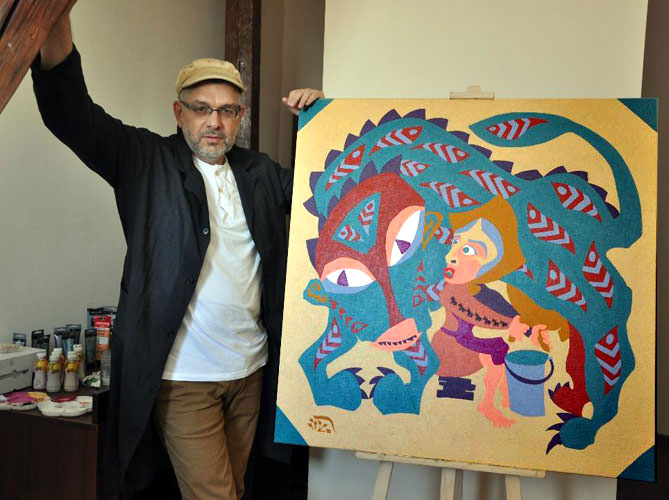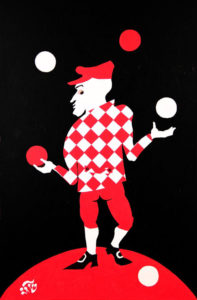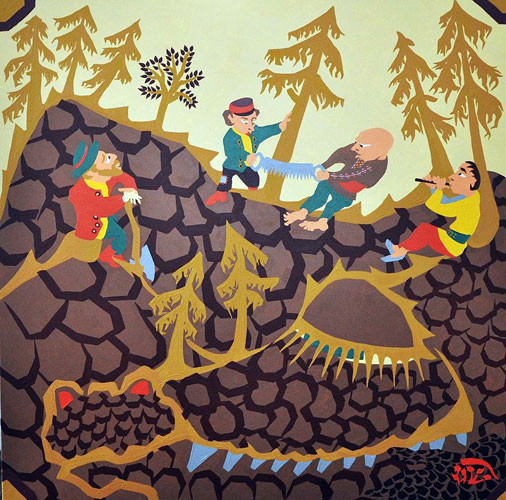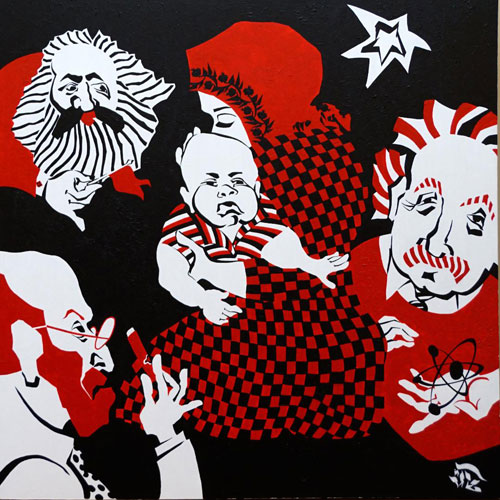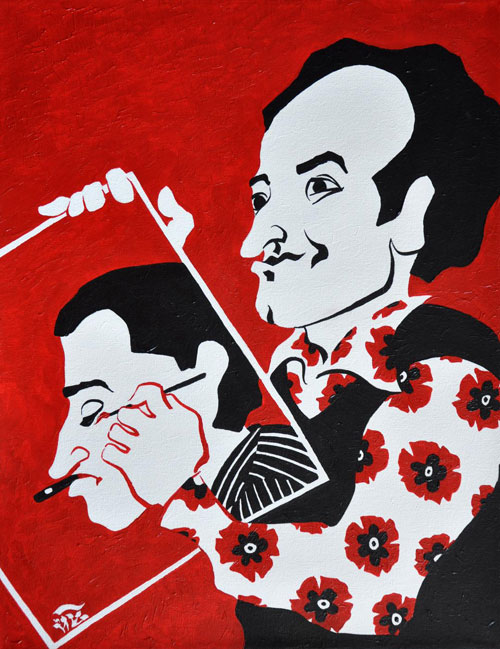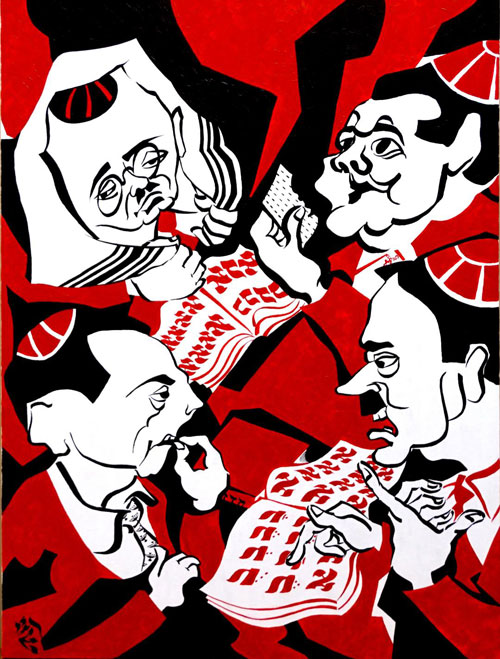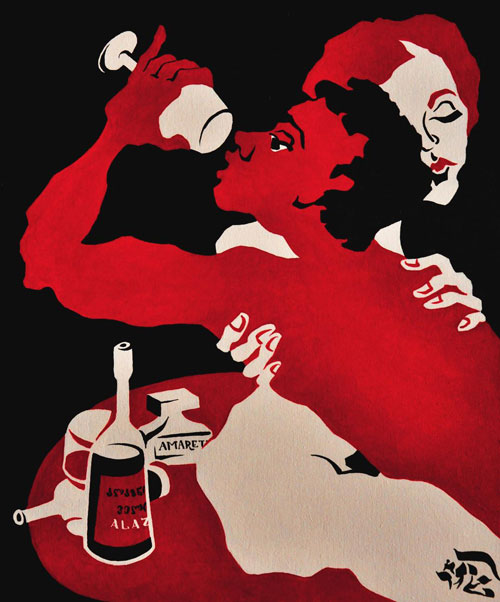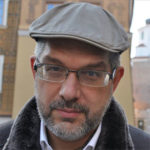Art, // January 26, 2020
Yohanan Petrovsky-Shtern — ARTIST
Interview with artist and scholar Yohanan Petrovsky-Shtern —
1. Who are you and what do you do?
I am a scholartist, a strange specie, half-a-scholar and half-an-artist. I inhabit a History Department office at Northwestern University where I place a canvas against my bookshelves and produce my paintings which are called scholart. This art is inspired by my interest in East European literature, history, and culture and is generated by my research in that field. My scholart painting is a fusion, a juxtaposition, and a synthesis. It creates an image that grows from intuition and results in a paradoxical vision that defies scholarship. What I cannot achieve in my scholarship, I seek to accomplish in my art.
2. Why art?
I’ve worked as a linguist, literary critic, translator, historian, scholar of religion and ethnography, and always found verbal expression deficient. There are moments in my teaching, usually the most dramatic, when words fail to convey what I’d like to impart to my students. I can explain the context, the behavior of the agents of historical calamities, the sinister logic of a catastrophe, and the results thereof. But when I need to talk about the victims’ experiences, words fail me. Millions of Ukrainians starved to death by the Soviet regime; millions of Jews gassed by the Nazis… Unable to cite the experience of the victims, I express their experience in my artwork. My suppressed emotions flow into brush strokes. To be precise, when I fail as a scholar I succeed as an artist.
3. What is your earliest memory of wanting to be an artist?
I was drawing incessantly from the early age, if one believes my elementary school classmates who told me about my obsession forty years later. But from a certain perspective, I still seek to be an artist. I use my sketch-book while getting sunburnt on the Tel Aviv beach, or when I am at a café in Jerusalem to try a draft-drawing for a new canvas. All of that because I dream of becoming an artist every moment of my life. From that perspective, my “earliest memory of wanting to be an artist” is not difficult to figure out: daily at about 6:45AM, when I wake up.
4. What are your favorite subject(s) and media(s)?
One feature about artistic medias excited me from early on: the smell. I love art stores, artistic studios, fresh painting on display primarily because of that tantalizing smell. Tempera, dry pastels, wax crayons, oil paints, India ink, casein gouache, and of course a just-sharpened KOH-I-NOOR pencil – these smells mesmerize me and push me to work. When it comes to work, of all medias I prefer heavy-duty “Golden” acrylic paints. They are thick as oils but dry much faster and leave rough surface which one might touch and feel. When I moved to the USA, I discovered precisely that new type of acrylic paints. This came as a revelation: it provided me with media I had spent years looking for and dreaming about. It is a paradox that the paints I am using regularly, acrylics, do not smell. I need to think whether to add turmeric and cardamom to my paints for fun.
5. How do you work and approach your subject?
My art is often mediated by my scholarship – or at least is filtered through it. My subject approaches me through multiple cultural filters. It crystallizes when I am listening to Gustav Mahler and Dimitri Shostakovich, reading Franz Kafka or T.S. Eliot, watching a Quentin Tarantino or a Andrzej Wajda movie. Sometimes it just opens up in my imagination and I see it before my eyes as an apparition; It is always a response to the surrounding cultural realm broadly conceived. Let me take my “Circus” series as an example. We are reminded that circus celebrates the omnipotence of human body and the supernatural qualities of human psyche. Robust, dexterous, agile circus artists. I am a rebel interested in a rebellion. The eyes of my brave gymnast betray fear, my juggler drops a ball, and my tamed animals refuse to obey the orders. And this is the moment I am trying to catch.
6. What are the best responses you have had to your work?
I enjoy inadvertently listening to visitor conversations at my shows. Often they say things I’d never thought about. Sometimes they engage me in a conversation sharing what they think while deciphering my visual messages. What I most appreciate about their feedback is that it tells me things I do not know about myself. Paul Jaskot, an art historian from Duke, found the “simplicity” of my artwork “deceptive” since my “complex” artwork “invokes a formal and conceptual rejection of the official artistic world” from which I came. Andreas Meier, a Swiss art historian, insightfully observed that the “color reduction to closed black-white-red areas” in my “graphic-looking art” is directly linked to Soviet Avant-garde and to the post-war American Pop-Art. Recently, I was thrilled when Andrew Horodysky, a New York gallery director and art critic, wrote about my most recent show that the “artist is able to transform even the most familiar lessons in human history into fantastically new visions, aphoristic tales re-imagined by his creative mind.”
7. What do you like about your work?
It keeps me alive, preserves my sanity, and helps me remain sober and balanced. Whatever its professional techniques, coloristic discoveries, whimsical images, and compositional innovations, my art helps me deal with vicissitudes of my life, with my scholarly ups and downs, with the loss of my children from the previous marriage who cut me off, and with my emotional over-reaction to horrible news we get these days from Australia, New York, and Ukraine. A new canvas or a sketch come as a healer, colors as a shrink, painting as a cure.
8. What advice would you give to other artists?
As one Greek famously said: Gnothi seauton. Be yourself. Do not be afraid to imitate great artists of past and present but always search for something your own. Show less detail and leave more for imagination. Read good books, listen to classical music, educate yourself. In order to become yourself.
9. Where do you see yourself in 5-10 years?
At MOMA. But I would not panic if this does not work. I am quite satisfied with my posthumous fame.
Yohanan Petrovsky-Shtern “with a little” yet crucial “help of my friend” John Varoli.
LINKS —
Website: http://yps.gallery
Facebook: YPS ART
Instagram: YPSARTYPS
Email: yps@northwestern.edu
Curriculum Vitae: www.history.northwestern.edu/people/faculty/core-faculty/yohanan-petrovsky-shtern.html
INFORMATION —
Yohanan Petrovsky-Shtern
The Crown Family Professor of Jewish Studies
, Professor of Jewish History, Department of History,
Northwestern University,
1881 Sheridan Road, Harris Hall, Room 317,
Evanston, Il 60208, U.S.A.
Phone: (847) 467-3399
Email: yps@northwestern.edu
NEXT SHOW —
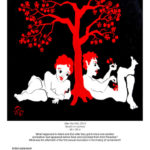 Zorya Fine Arts Gallery, Greenwich, CT
Zorya Fine Arts Gallery, Greenwich, CT
Opening: January 23, 2020
PREVIOUS SHOWS —
https://www.zoryafineart.com/artists/141/yohanan-petrovsky-shtern
http://lvivgallery.org.ua/exhibitions/erotyka-kurtuazna-ta-ironichna-v-grafici-ta-zhyvopysi
https://kyiv-online.net/events/arts/vystavka-johanan-petrovskyj-shtern-ya-ni-pro-scho-ne-shkoduyu/
https://ukrainianinstitute.org/event/the-tales-and-myths-of-yohanan-petrovsky-shtern/
https://ukrainianinstitute.org/event/yohanan-petrovsky-shtern-legends-and-parables/
http://www.ukrainianmuseum.org/ex_150329_talesandmyths.html
https://uima-chicago.org/new-blog/2014/2/1/survival-spirit-dreams-nightmares
https://www.spertus.edu/exhibits/yps
ART CRITICISM & INTERVIEWS —
http://artukraine.com.ua/eng/a/petrovsky/#.Xhy_hudKjVo
https://jewishweek.timesofisrael.com/reimagined-jewish-folk-art-at-the-ukrainian-institute/
http://www.ukrweekly.com/uwwp/historian-and-artist-yohanan-petrovsky-shtern/
http://www.ukrainianmuseum.org/ex_150329_talesandmyths.html
https://www.weinberg.northwestern.edu/after-graduation/weinberg-magazine/crosscurrents-archive/2012-2013-fall-winter/two-artists.html
https://yps.gallery/whoheis.php



